It all started with Nelly van Doorn - Harder having the idea of inviting Emha Ainun Nadjib to the Netherlands and organizing a symposium on art and religion. Being based in the US she asked me to be her extra pair of hands and eyes on the spot (as we were already working together on an interreligious dialogue project together). Soon after this I learned the idea had been dropped elsewhere, too, and I was happy to join Aart Verburg as co-organizer of what would become a real tour.
When, eleven months later, the symposium really took place, as one in a series of events we had managed to plan, it still felt like the central thing to me. Looking back on the whole tour it is one of a few things that really stand out for me.
Visionary Art
A symposium on the relationship between religion and art, that’s what Nelly had wanted it to be, and that’s what it was. She had invited a singer, Rajae El Mouhandiz, a young North-African/Dutch woman (her parents were from Morocco and Algeria and she grew up in the Netherlands) and two Dutch artists, Tom America, a composer and creator of video-Gesammtkunstwerke and Tijn Touber, former pop musician, writer and meditation teacher.
Rajae sang her songs accompanied by keyboard and guitar. She explained what had brought her to write songs like ‘Subhanallah’, ‘The hand of Fatima’ and ‘I want peace in the Middle-East’. It was wonderful to see such a beautiful self-assured young woman standing on stage, making explicit the religious aspects of her very modern, bluesy, jazzy, ballad-like songs.
Tom gave a presentation about his development as an artist, that had recently led to a video project on a multi-ethnic part of his native city Tilburg, ‘Noord’ (north). He showed the audience how he had turned interviews with people from all over the world, that had come to this part of the city mostly as refugees, into impressive, sometimes slightly disturbing art.
Tijn sketched his spiritual development along with developments in society. He quoted a friend who had said: ‘As uninspired structures collapse, inspiration gets more and more structured.’ and he suggested that people stand up and start living as if they were already enlightened. ‘Focus on what is actually present in yourself, tune in on that.’ He and his partner Kristia finished his contribution with a song: ‘Here comes the light’.
Professor Wessel Stoker (aesthetics and theology, Free University of Amsterdam) responded to these three performances in a lecture in which he compared art to the Eucharist. He contended that art can touch people as does this celebration, on a deeper level that is, and for that reason it can reach more results than argued policies.
The symposium was closed with another song by Rajae, a cappella this time, for her accompanying musicians had already left. And Emha answered to that by singing a prayer in Javanese, which Novia then sang in an English translation. Maybe, Emha concluded, artists know more about religion than Ulama do.
High and low culture
Kiai Kanjeng had suggested they’d sing one or two songs in Dutch. The group had exchanged e-mail messages with Heri Sasmito on the choice of the songs. One was ‘Als de orchideeën bloeien’ [Bunga anggrek / When the orchids bloom], a classic from colonial times if I am not mistaken. The other ‘Heb je even voor mij?’ [Can you spare me a moment?], a very popular song by a Dutch singer called Frans Bauer. I have to admit I hadn’t been happy when I heard it had been proposed as the representative of today’s Dutch popular music culture. But okay… I swallowed my snobbism when Novia asked me to help her and the other singers of the band to get the pronunciation of both songs right. There we were, sitting around a small table in the embassy’s guesthouse, rehearsing unfamiliar sounds. This was good, no matter the song, we were together. Done with snobbism, once and for all. The more so, when I saw how the song functioned during the concerts, and how enthusiastically people responded to it, joined in, sang along.
Soul
After the Rotterdam concert at the Islam and Dialogue Foundation, I left without having said good-bye to Emha. He seemed to have suddenly disappeared. Ah no, there was a simple explanation, I saw a small group out on the pavement, smoking. But before I could join it, I heard my name being called behind me. It was Emha. While I wanted to thank him for the concert, he started thanking me for the Visionary Art symposium. He took my hands in his and said: ‘It was such a good symposium, really. We can only do what we think is right, and we continue to do so, as we feel we’re all part of a larger design, you and I and all of us, we may not understand its scope, but we contribute to it, with our art, and so did you with your symposium on art and religion.’ I was rather embarrassed, stammered that I had just helped Nelly, but Emha made me understand, not so much with his words, but rather with his hands and his eyes, that his words were meant for me, and that I could receive their meaning just like that, no need to be afraid to look arrogant, nor was any undue modesty needed.
Unexpected perspective
On the second Friday Amsterdam was on the program again and I was asked to taxi Emha from the guest house to the capital. It was a sunny day and we listened to tango music during the ride – music of the heart, too.
Emha was received cordially at the Al Fatih Mosque and after Friday’s Prayers met with representatives of CMO, a platform for official contact between Dutch Muslims and the Dutch government. I was particularly impressed by the way the CMO president, Mr. Driss El Boujoufi, sketched the history of immigration and explained how religion is interwoven in this history, and in Dutch society as a whole. Emha was not the only one learning about the Dutch situation. I found out that the introduction given to someone much less familiar with that situation than I was, was unexpectedly enlightening for me too, offering a perspective I had never taken before.
It was good to see how Emha and Mr. Boujoufi, in the hour and a half that the meeting lasted had become acquainted, learned from each other and said good-bye as brothers.
Gerardus Majella
On that second Friday evening a concert was scheduled in a church again, a Roman-Catholic church this time – let’s not forget the ecumenical perspective while focussing on interreligiosity and interculturallity.
The hall of the modern building was slowly filled with people, again with all different backgrounds and origins, from the parish, from the neighbourhood, Indonesian, Moroccan, Dutch. The parish priest had warned me with a smile, there would be ‘some scum’ too, by which he meant the homeless men coming to his church every Thursday, to prepare a meal and have dinner together.
People were singing along and Emha explained how he and his band want to bridge differences by means of music – no accident that there are many songs about love, from Indonesia, but also from Lebanon, China and Europe: Frans Bauers song again and, more international, Imagine, L-o-v-e, Stand by me and Where do I begin.
A wonderful detail: Emha recited from the Quran, with the appropriate ‘melody’. Two Moroccan boys joined in. Then he told the audience that ‘back home’ the text is sung to a Javanese melody, and he showed them how. The boys joined in again.
Workshop in Amsterdam
The last public event of the tour was a musical workshop. We had found a venue in a cultural centre, a former church, called Podium Mozaiek, in a part of Amsterdam that has not always been ‘media-genic’, for reasons of social unrest caused by angry young Moroccans.
On an early Saturday morning the group installed their instruments in a large room that looked a bit like a ballet studio.
As time passed by I got more and more nervous as less than 10 people turned up. I looked for Emha and what he said was such a lesson for me, perfectionist: ‘We are honored to be invited, to be here, we perform with love, no matter how many or how little people come, think of the larger design.’ I was touched by his… not acceptance (that would imply that deep down inside he would have preferred otherwise), rather ‘his vision’: it’s okay the way it turns out to be, however it turns out to be. It was so … gentle.
And as the workshop advanced, more people did come in, and we ended up with a nice group of very interested people. Unfortunately no one brought an instrument, but there was a young woman who had brought her voice, and a wonderful voice it was. She was of Surinam origin, and told Emha that ever since she was a little girl she had wanted to sing Javanese songs. ‘No, I didn’t know what I was singing, but I felt it!’ She joined in with the band and really a star was born!
Emha told the audience about the gamelan (partly present, partly imitated by keyboard), its geographic origin, and the kinds of music that can be played with it, all the while illustrating his words with fragments of music and singing. And he explained how the original ‘tonality’ of the instrument had been ‘extended’ to be able ‘to play across borders’. While commenting on the songs the band was playing, he linked up, smilingly, horizontal and vertical love, that is love between people and love between heaven and earth respectively.
After the workshop audience and musicians had lunch together (and a cigarette) in a very informal way. Novia and I came back to ‘Heb je even voor mij? / Can you spare me a moment?’ I learned that dangdut was as popular a style as this Frans Bauer song. Why had I liked the dangdut songs on first hearing them and did I dislike the Dutch song? We just smiled to each other for an answer.
The event was concluded with almost all participants sitting in a circle. ‘Music is a language that reaches your emotions directly though your ears, that’s why it is so apt for building bridges and bridging gaps.’
Nelleke de Jong – van den Berg
December 14th, 2008
Nelleke de Jong - van den Berg, married, son of 16, daughter of 14 years old. Studied French Linguistics and Literature and then Translation Studies. Phd in Translation Studies. Collaborated in a project of (ecumenical) bible translation. Part-time staff member of the Centre for Reflection of the Protestant Church in the Netherlands, focussing on interreligious dialogue. With Aart Verburg co-coordinator of Voices & Visions project. In her spare time, dances the Argentinean tango and loves reading novels and poetry.
When, eleven months later, the symposium really took place, as one in a series of events we had managed to plan, it still felt like the central thing to me. Looking back on the whole tour it is one of a few things that really stand out for me.
Visionary Art
A symposium on the relationship between religion and art, that’s what Nelly had wanted it to be, and that’s what it was. She had invited a singer, Rajae El Mouhandiz, a young North-African/Dutch woman (her parents were from Morocco and Algeria and she grew up in the Netherlands) and two Dutch artists, Tom America, a composer and creator of video-Gesammtkunstwerke and Tijn Touber, former pop musician, writer and meditation teacher.
Rajae sang her songs accompanied by keyboard and guitar. She explained what had brought her to write songs like ‘Subhanallah’, ‘The hand of Fatima’ and ‘I want peace in the Middle-East’. It was wonderful to see such a beautiful self-assured young woman standing on stage, making explicit the religious aspects of her very modern, bluesy, jazzy, ballad-like songs.
Tom gave a presentation about his development as an artist, that had recently led to a video project on a multi-ethnic part of his native city Tilburg, ‘Noord’ (north). He showed the audience how he had turned interviews with people from all over the world, that had come to this part of the city mostly as refugees, into impressive, sometimes slightly disturbing art.
Tijn sketched his spiritual development along with developments in society. He quoted a friend who had said: ‘As uninspired structures collapse, inspiration gets more and more structured.’ and he suggested that people stand up and start living as if they were already enlightened. ‘Focus on what is actually present in yourself, tune in on that.’ He and his partner Kristia finished his contribution with a song: ‘Here comes the light’.
Professor Wessel Stoker (aesthetics and theology, Free University of Amsterdam) responded to these three performances in a lecture in which he compared art to the Eucharist. He contended that art can touch people as does this celebration, on a deeper level that is, and for that reason it can reach more results than argued policies.
The symposium was closed with another song by Rajae, a cappella this time, for her accompanying musicians had already left. And Emha answered to that by singing a prayer in Javanese, which Novia then sang in an English translation. Maybe, Emha concluded, artists know more about religion than Ulama do.
High and low culture
Kiai Kanjeng had suggested they’d sing one or two songs in Dutch. The group had exchanged e-mail messages with Heri Sasmito on the choice of the songs. One was ‘Als de orchideeën bloeien’ [Bunga anggrek / When the orchids bloom], a classic from colonial times if I am not mistaken. The other ‘Heb je even voor mij?’ [Can you spare me a moment?], a very popular song by a Dutch singer called Frans Bauer. I have to admit I hadn’t been happy when I heard it had been proposed as the representative of today’s Dutch popular music culture. But okay… I swallowed my snobbism when Novia asked me to help her and the other singers of the band to get the pronunciation of both songs right. There we were, sitting around a small table in the embassy’s guesthouse, rehearsing unfamiliar sounds. This was good, no matter the song, we were together. Done with snobbism, once and for all. The more so, when I saw how the song functioned during the concerts, and how enthusiastically people responded to it, joined in, sang along.
Soul
After the Rotterdam concert at the Islam and Dialogue Foundation, I left without having said good-bye to Emha. He seemed to have suddenly disappeared. Ah no, there was a simple explanation, I saw a small group out on the pavement, smoking. But before I could join it, I heard my name being called behind me. It was Emha. While I wanted to thank him for the concert, he started thanking me for the Visionary Art symposium. He took my hands in his and said: ‘It was such a good symposium, really. We can only do what we think is right, and we continue to do so, as we feel we’re all part of a larger design, you and I and all of us, we may not understand its scope, but we contribute to it, with our art, and so did you with your symposium on art and religion.’ I was rather embarrassed, stammered that I had just helped Nelly, but Emha made me understand, not so much with his words, but rather with his hands and his eyes, that his words were meant for me, and that I could receive their meaning just like that, no need to be afraid to look arrogant, nor was any undue modesty needed.
Unexpected perspective
On the second Friday Amsterdam was on the program again and I was asked to taxi Emha from the guest house to the capital. It was a sunny day and we listened to tango music during the ride – music of the heart, too.
Emha was received cordially at the Al Fatih Mosque and after Friday’s Prayers met with representatives of CMO, a platform for official contact between Dutch Muslims and the Dutch government. I was particularly impressed by the way the CMO president, Mr. Driss El Boujoufi, sketched the history of immigration and explained how religion is interwoven in this history, and in Dutch society as a whole. Emha was not the only one learning about the Dutch situation. I found out that the introduction given to someone much less familiar with that situation than I was, was unexpectedly enlightening for me too, offering a perspective I had never taken before.
It was good to see how Emha and Mr. Boujoufi, in the hour and a half that the meeting lasted had become acquainted, learned from each other and said good-bye as brothers.
Gerardus Majella
On that second Friday evening a concert was scheduled in a church again, a Roman-Catholic church this time – let’s not forget the ecumenical perspective while focussing on interreligiosity and interculturallity.
The hall of the modern building was slowly filled with people, again with all different backgrounds and origins, from the parish, from the neighbourhood, Indonesian, Moroccan, Dutch. The parish priest had warned me with a smile, there would be ‘some scum’ too, by which he meant the homeless men coming to his church every Thursday, to prepare a meal and have dinner together.
People were singing along and Emha explained how he and his band want to bridge differences by means of music – no accident that there are many songs about love, from Indonesia, but also from Lebanon, China and Europe: Frans Bauers song again and, more international, Imagine, L-o-v-e, Stand by me and Where do I begin.
A wonderful detail: Emha recited from the Quran, with the appropriate ‘melody’. Two Moroccan boys joined in. Then he told the audience that ‘back home’ the text is sung to a Javanese melody, and he showed them how. The boys joined in again.
Workshop in Amsterdam
The last public event of the tour was a musical workshop. We had found a venue in a cultural centre, a former church, called Podium Mozaiek, in a part of Amsterdam that has not always been ‘media-genic’, for reasons of social unrest caused by angry young Moroccans.
On an early Saturday morning the group installed their instruments in a large room that looked a bit like a ballet studio.
As time passed by I got more and more nervous as less than 10 people turned up. I looked for Emha and what he said was such a lesson for me, perfectionist: ‘We are honored to be invited, to be here, we perform with love, no matter how many or how little people come, think of the larger design.’ I was touched by his… not acceptance (that would imply that deep down inside he would have preferred otherwise), rather ‘his vision’: it’s okay the way it turns out to be, however it turns out to be. It was so … gentle.
And as the workshop advanced, more people did come in, and we ended up with a nice group of very interested people. Unfortunately no one brought an instrument, but there was a young woman who had brought her voice, and a wonderful voice it was. She was of Surinam origin, and told Emha that ever since she was a little girl she had wanted to sing Javanese songs. ‘No, I didn’t know what I was singing, but I felt it!’ She joined in with the band and really a star was born!
Emha told the audience about the gamelan (partly present, partly imitated by keyboard), its geographic origin, and the kinds of music that can be played with it, all the while illustrating his words with fragments of music and singing. And he explained how the original ‘tonality’ of the instrument had been ‘extended’ to be able ‘to play across borders’. While commenting on the songs the band was playing, he linked up, smilingly, horizontal and vertical love, that is love between people and love between heaven and earth respectively.
After the workshop audience and musicians had lunch together (and a cigarette) in a very informal way. Novia and I came back to ‘Heb je even voor mij? / Can you spare me a moment?’ I learned that dangdut was as popular a style as this Frans Bauer song. Why had I liked the dangdut songs on first hearing them and did I dislike the Dutch song? We just smiled to each other for an answer.
The event was concluded with almost all participants sitting in a circle. ‘Music is a language that reaches your emotions directly though your ears, that’s why it is so apt for building bridges and bridging gaps.’
Nelleke de Jong – van den Berg
December 14th, 2008
Nelleke de Jong - van den Berg, married, son of 16, daughter of 14 years old. Studied French Linguistics and Literature and then Translation Studies. Phd in Translation Studies. Collaborated in a project of (ecumenical) bible translation. Part-time staff member of the Centre for Reflection of the Protestant Church in the Netherlands, focussing on interreligious dialogue. With Aart Verburg co-coordinator of Voices & Visions project. In her spare time, dances the Argentinean tango and loves reading novels and poetry.

































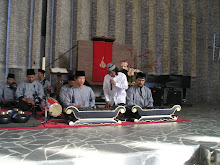
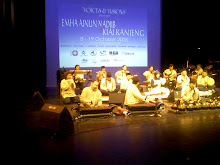

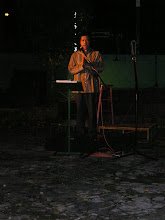



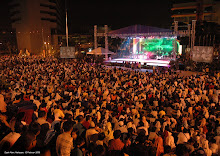
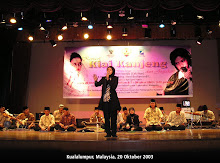
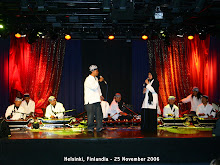.jpg)



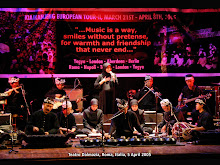


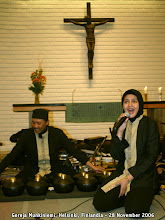.jpg)

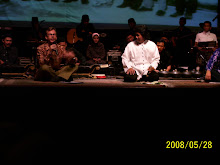.jpg)
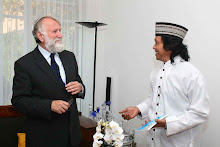
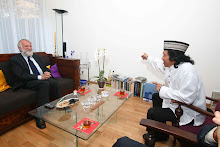
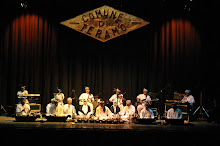


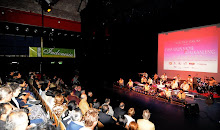

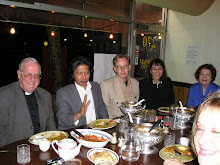


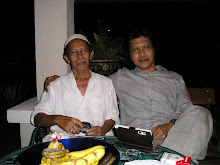
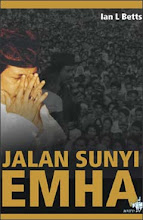
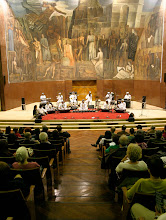
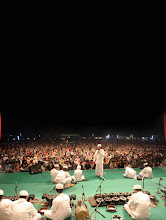

No comments:
Post a Comment